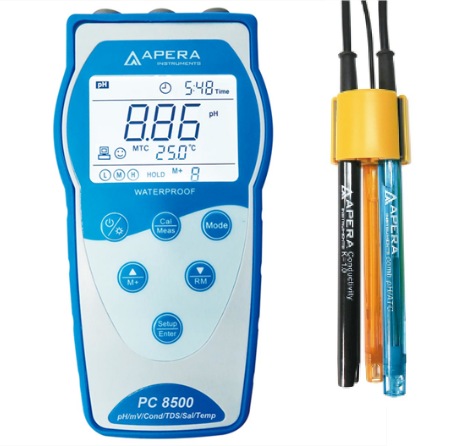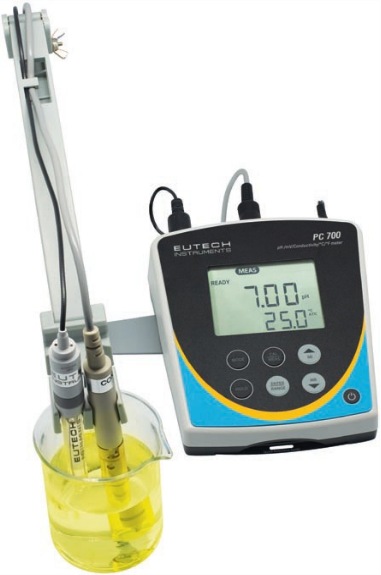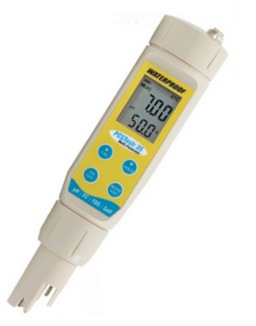How does a pH and conductivity meter work?

pH and conductivity are key parameters to measure the acidity and the basicity of a substance while monitoring the level of nutrients, salts or impurities present. pH and conductivity measurements are used in a variety of applications, including boiler maintenance and agriculture, as well as aquariums and aquaculture.
A pH and conductivity meter is a fast, reliable and inexpensive way to measure the pH and ionic content of a liquid. So, how do such meters work?
What are pH and conductivity?
The potential of hydrogen or ‘pH’ is the measure of hydrogen ion concentration in a sample used to determine the acidity or alkalinity of a product. The pH scale ranges from 0-14 with 0 being acidic, 7 being neutral, and 14 being alkaline.
Electrical conductivity is the measure of the concentration of ions present within a sample. This is calculated by the ability of the substance to transmit an electrical current over a defined area. The measurement unit for electrical conductivity is called Siemens(S) (E.g. Milli Siemens per centimetre mS/cm or Micro Siemens per cm μS/cm).
Is there a relationship between pH and electrical conductivity?
As discussed, pH is the measurement of a specific ion (i.e. hydrogen). In contrast, electrical conductivity is a non-specific measurement of the concentration of both positively and negatively charged ions within a sample.
So to summarise, the relationship between pH and conductivity is that the presence of hydrogen ions present will impact the pH level of a substance, and the presence of these ions will probably influence the conductivity level. However, hydrogen ions make up only a small part of the ion concentration measured by a conductivity meter. So given this, the relevance of the relationship will depend on the presence of hydrogen in comparison with other concentrations of non pH determining ions.
How pH and conductivity meters work
There is a wide range of electrodes and meters available for specific applications. On the Instrument Choice website you can find meters featuring pH and conductivity built into one electrode or as separate electrodes. More information on specific electrodes can be found by contacting one of our Scientists. Here, we will cover the general workings of a pH and conductivity meter. So, how do these instruments work?
Electrical Conductivity
Electrical conductivity is measured by conductance between two or four electrodes using amperometric or potentiometric methods. When submerged in a sample the electrodes pass a current through the sample solution. The relative concentration of ions within the solution will determine the conductivity or the resistivity of the sample. Conductivity is expressed as Siemens units.
- 2 electrode probes (Amperometric) – These work through two electrodes isolated from one another. Made from non-reactive material and constructed so both will be in contact with the sample at the same time. These two electrodes pass a current through the sample at a specific frequency and the more ions present, the higher the EC reading. EC-PCSTestr35 is a good example.
- 4 electrode probe (Potentiometric) – This has four platinum rings on the electrode body. The top and bottom rings (on the outside) apply an alternating voltage to the sample and induces a current. The centre rings (placed to the inside of the top and bottom rings) measure the potential drop in the current generated by the outside electrodes, thus giving an electrical conductivity reading. The PC8500 uses this example.
pH Meter
A pH electrode consists of a reference electrode, reference solution, reference junction and a glass bulb with a hydrated gel layer. Once the electrode is submerged in a sample this creates a current that measures the charge of the reference solution inside the bulb compared to the solution on the outside of the gel layer. The result is a pH measurement.
What are some uses for a pH and conductivity meter?
Electrical pH and conductivity are important in several applications and industries. Below are just a few examples of the many applications.
Aquariums and aquaculture – An easy way to check the salinity of any water is with a pH and conductivity meter. In addition, you can either convert to total dissolved solids (TDS) or salinity manually or simply use a pH and conductivity meter that has this conversion feature built in. An example of a pH and conductivity meter with this feature can be seen here.
Salinity measurement via conductivity is important to measure as it can affect the osmoregulation of salt and freshwater fish. The optimum pH differs for fish species, the ideal range is generally between 6.5 to 9pH. Outside of this range, you will see slow or sub-optimum growth, no reproduction and extreme cases (pH 4 and below, pH 11 and up) death.
Boiler Maintenance – Boilers have a large amount of feed water in the system. This water has impurities which over time can cause issues. This occurs during typical boiler use as the water is heated and turned to steam the impurities are left behind. Over time, these will build up and impact the efficiency of the boiler system. Having a pH and conductivity meter will easily allow monitoring of the impurities in the water to indicate when a boiler blowdown should occur. Monitoring the pH is also important as acidic water is highly corrosive and alkaline water may cause some scaling in the system.
Agriculture – Electrical conductivity can be used to infer the amount of salinity, dissolved nutrients and dissolved solids in soil. This is a good way to tell if more water or fertiliser is needed. Soil pH affects the uptake of key nutrients, so when pH is out of the ideal range there is a chance your plants and crops are not having optimum nutrient uptake and therefore not reaching their full growth potential. See our article ‘How to use a soil pH meter’ for more information on how pH can affect soil quality.
Making accurate measurements on your pH and conductivity meter
|
IC TIP: For accurate results - lookout for pH and conductivity meters with automatic temperature compensation. |
One parameter which can influence your pH and conductivity meter result is temperature. If the solution is at a higher temperature the electrical resistance may drop and therefore increase the conductance. Conversely, if a solution is cooled the conductance will drop and increase the resistivity.
To ensure accuracy, pH and conductivity meters need to be properly calibrated before each use. Generally, with pH, you should use a pH buffer solution on either side of your expected results. For example, if you are expecting results of 5.3 – you can use buffer solutions 4.01 and 7.00. The more calibration points along the linear pH scale the more accurate you can expect your results to be. Instrument Choice recommends a minimum of two-point pH calibration.
See how to calibrate your pH meter here.
For conductivity, the most common calibration solution is 1413µS/cm. However, check your manual as some meters will only calibrate to specific points.
Some examples of combined pH and conductivity meters available on the Instrument Choice Website
- pH Range 0.0 to 14.0 pH
- Conductivity range 0.0 to 199.9µS/cm, 200 to 1999 uS/cm and 2.0 to 20.00 mS/cm.
- Temperature compensation for accurate results
- Never lose your meter to Poseidon again, this meter is waterproof and designed to float.
- Select from 3- or 5-point pH calibration
- Highly accurate and quick readings
- Measures temperature, Salinity and TDS
- Rated as the longest-lasting tester on the market
Portable pH/Conductivity Meter Kit IC- PC8500

- pH range of -2.00 to 16.00
- Conductivity range 0 to 200mS/cm
- Temperature compensation for accurate results
- Log up to 500 data groups and upload to a computer via USB output
- 1, 2- or 3-point pH calibration
- Water and Dustproof design for extra durability
- Easy care with automatic calibration, calibration reminder and self-diagnostics
Benchtop meter for pH/Conductivity and TDS – EC-PC700-43S

- pH range of -2.00 to 16.00 pH
- Conductivity range 0.0µS to 200.0mS
- Automatic temperature compensation
- Easily interchangeable separate pH and conductivity electrodes.
- Up to 5-point pH calibration for accurate results.
- Memory holds up to 100 data points.
- Selectable cell constant
- Also accepts TDS and Redox probes
Conclusion
pH and Conductivity meters are essential tools across a range of applications and industries. While the inner workings are complex, they have been designed to be tough and easy to use. You can see many examples in addition to those feature in this article on the Instrument Choice website.
Have some questions about pH and conductivity? Need a bit more help choosing the best pH and conductivity meter for your application? Call one of our friendly scientists on 1300 737 871 or email [email protected].
Also interesting
Brix meters are devices used for an assortment of jobs across many industries, but most notably in the food and beverage industry. They provide a quick and accurate measurement of Brix in almost any liquid sample. If you have ever used a Brix meter and become even slightly curious about its inner workings, wonder no more.

While noise is a part of life, regular, prolonged, or unprotected exposure to loud sounds is hazardous. This article focusses on how you can measure noise, and we provide examples of some of the most popular, contemporary devices you can use to measure noise levels.


